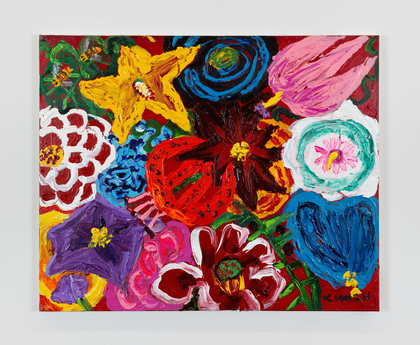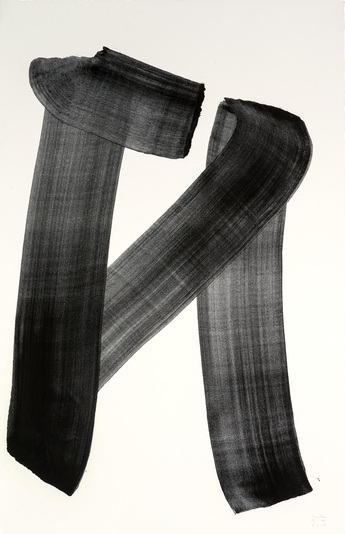-
From Current Issue
-
- Editor’s Letter Fire in the Heart
- Reviews I Gusti Ayu Kadek Murniasih
- Reviews 11th Seoul Mediacity Biennale: “One Escape at a Time”
- Dispatch Networked China
- One on One Monira Al Qadiri on Yukio Mishima
- Essays The rise of independent art spaces in pandemic-era Shanghai
- Features Tuan Andrew Nguyen
- Table of Contents
- Web Exclusives
- Archive
- Subscribe

R
E
V N
E
X
T
Installation view of “Floating World,” at Perrotin, Hong Kong, 2020–21. Photo by Ringo Cheung. All images courtesy the artists and Perrotin, Paris / Hong Kong / New York / Seoul / Tokyo / Shanghai.
The Floating World commonly refers to Japan’s thriving Edo Period (1603–1868), when theaters and pleasure districts flourished under economic advancements and urbanization. These quarters, immortalized in Ukiyo-e images of kabuki actors and courtesans, developed outside of societal constraints and reality. The name, however, stems from the Buddhist concept of a transitory life with an endless cycle of reincarnation and suffering, a more sorrowful world that the hedonistic districts sought to temporarily obscure. Perrotin Hong Kong’s exhibition of the same name draws upon elements of both meanings through the works of 12 artists, attempting to capture this illusory, evanescent world.
Most apropos of the Edo narrative was Laurent Grasso’s Studies into the Past (2016), an imposing trio of oil-and-gold-leaf works installed like traditional folding screens. For this series, Grasso appropriates pre-modern styles and motifs that blur fantasy and fact to invoke what he refers to as “false historical memory,” like a reconstructed alternate universe. Here, a dark red orb dominates the central panel, flanked by a single equestrian figure in medieval costume, and an elaborate aerial view of a feudal Japanese town. Celestial phenomena are rare in pre-modern works due to lack of scientific knowledge but often incorporated by Grasso to highlight perpetually changing perceptions of the world. In another ahistorical twist, the work comingles time periods and geography, alluding to the co-existence of the horseman and the townsfolk despite their lack of awareness of the other in reality.
Some works were more personal. Sophie Calle’s intimate photograph of a bouquet, Mama (dans le vase) n°3 (2012), embodies an aching vulnerability that accentuates life’s fragility. A tribute to the artist’s late mother, the image strikingly contrasts the fresh flowers with the coldness of the stone vase and marble slab underneath. Nearby, similar in subject but different in tone, Kim Chong-hak’s Untitled (2018) acrylic painting of abstracted blooms features his signature vigorous and colorful composition. In the 1970s, during a mountain retreat at Seoraksan to treat his depression, the artist became enamoured with the beauty and strength of nature, to which he dedicated his practice. With the vibrant flowers imprinted in his mind, he paints with speed and energy to convey vitality.
The second room centered repetitive and meditative practices utilizing specific forms or mediums. Lee Bae’s paper work Brushstroke-98 (2019) depicts thick, black bands in ink made with charcoal, the artist’s hallmark medium. A product of burnt wood that is then used to ignite fires, charcoal infers the cycle of life. Lee’s seemingly spontaneous, gestural strokes are in fact the result of meticulous layering, documenting the passage of time. Meanwhile, Jean-Michel Othoniel’s ink-on-gold leaf Peony, The Knot of Shame (2014) is an imprint of a strand of beads curled in the shape of the flower, and marks a departure in medium for the artist, who is known for his modular sculptures of vibrant glass orbs. Playful yet fragile, Othoniel’s sculptures insinuate both beauty and death. Here, the canvas’s title suggests a reference to the nymph Paeonia of Greek mythology, who was turned into a peony by the goddess Aphrodite out of jealousy. Inadvertently, Aphrodite made Paeonia immortal, preserving her beauty in an altered form.
The curatorial conceptions of a “Floating World” were less readily apparent in other adjacent works, although they touch on notions of flux. Mounted near the gallery windows overlooking Victoria Harbour, Bernard Frize’s abstraction Pator (2012), showing broad strokes of aquamarine, mirrored the undulating waves outside. Nearby, Xavier Veilhan’s sculpture Mobile n°16 (2016), composed of stainless steel circles and cork spheres dangling from an elongated wooden stand, continued this sense of motion and uncertainty. Among these serene works, Georges Mathieu’s dark-hued Composition (1989–90), featuring rapid, charged calligraphic strokes, appeared out of place with its ecstatic energy.
“Floating World” was an eclectic display of works that spoke to the impermanence of not only joy and pain but also life itself. This was a timely theme during a deadly pandemic, but the show could have perhaps benefited from including fewer pieces that honed this idea rather than a wide and uneven assortment. Nevertheless, the artworks themselves were engaging, revealing the fugaciousness of our surroundings.
Lauren Long is ArtAsiaPacific’s news and web editor.
“Floating World” is on view at Perrotin, Hong Kong, until February 6, 2021.
To read more of ArtAsiaPacific’s articles, visit our Digital Library.

















